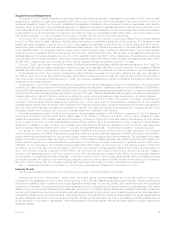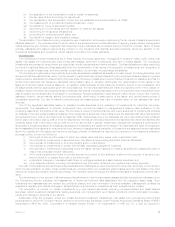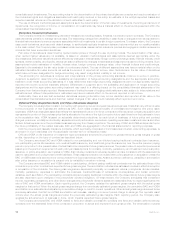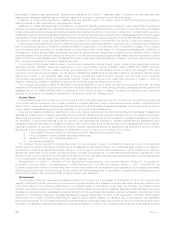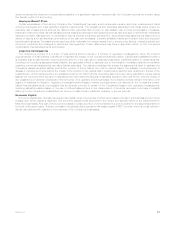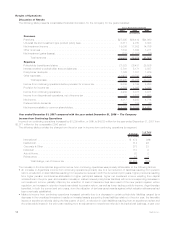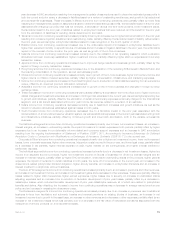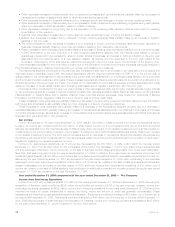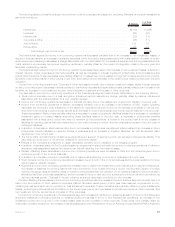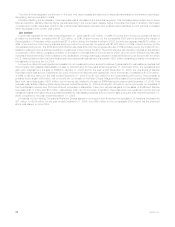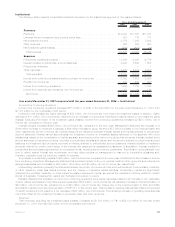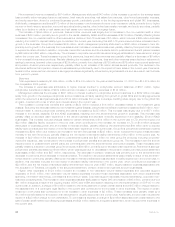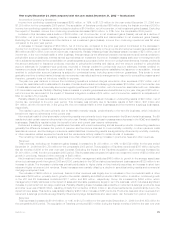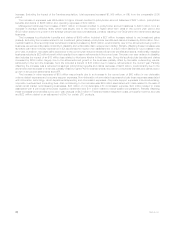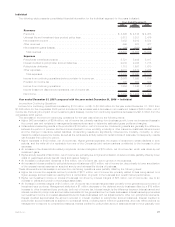MetLife 2007 Annual Report Download - page 21
Download and view the complete annual report
Please find page 21 of the 2007 MetLife annual report below. You can navigate through the pages in the report by either clicking on the pages listed below, or by using the keyword search tool below to find specific information within the annual report.
investment income attributable to higher yields was primarily due to higher returns on fixed maturity securities, other limited partnership
interests excluding hedge funds, equity securities and improved securities lending results, partially offset by lower returns on real estate
joint ventures, cash, cash equivalents and short-term investments, hedge funds and mortgage loans. Management anticipates that
investment income and the related yields on other limited partnership interests may decline during 2008 due to increased volatility in the
equity and credit markets during 2007.
Interest Margin
Interest margin, which represents the difference between interest earned and interest credited to policyholder account balances
increased in the Institutional and Individual segments for the year ended December 31, 2007 as compared to the prior year. Interest earned
approximates net investment income on investable assets attributed to the segment with minor adjustments related to the consolidation of
certain separate accounts and other minor non-policyholder elements. Interest credited is the amount attributed to insurance products,
recorded in policyholder benefits and claims, and the amount credited to policyholder account balances for investment-type products,
recorded in interest credited to policyholder account balances. Interest credited on insurance products reflects the current year impact of
the interest rate assumptions established at issuance or acquisition. Interest credited to policyholder account balances is subject to
contractual terms, including some minimum guarantees. This tends to move gradually over time to reflect market interest rate movements
and may reflect actions by management to respond to competitive pressures and, therefore, generally does not introduce volatility in
expense.
Net Investment Gains (Losses)
Net investment losses decreased by $644 million to a loss of $738 million for the year ended December 31, 2007 from a loss of
$1,382 million for the comparable 2006 period. The decrease in net investment losses was primarily due to a reduction of losses on fixed
maturity securities resulting principally from the 2006 portfolio repositioning in a rising interest rate environment, increased gains from
asset-based foreign currency transactions due to a decline in the U.S. dollar year over year against several major currencies and increased
gains on equity securities, partially offset by increased losses from the mark-to-market on derivatives and reduced gains on real estate and
real estate joint ventures.
Underwriting
Underwriting results are generally the difference between the portion of premium and fee income intended to cover mortality, morbidity
or other insurance costs, less claims incurred, and the change in insurance-related liabilities. Underwriting results are significantly
influenced by mortality, morbidity or other insurance-related experience trends, as well as the reinsurance activity related to certain blocks
of business. Consequently, results can fluctuate from period to period. Underwriting results, excluding catastrophes, in the Auto & Home
segment were less favorable for the year ended December 31, 2007, as the combined ratio, excluding catastrophes, increased to 86.3%
from 82.8% for the year ended December 31, 2006. Underwriting results were favorable in the non-medical health & other, group life and
retirement & savings businesses in the Institutional segment. Underwriting results were unfavorable in the life products in the Individual
segment.
Other Expenses
Other expenses increased by $890 million, or 8%, to $11,673 million for the year ended December 31, 2007 from $10,783 million for
the comparable 2006 period.
The following table provides the change from the prior year in other expenses by segment:
$ Change %ofTotal
$ Change
(In millions)
Individual........................................................ $512 57%
International ...................................................... 219 25
Institutional....................................................... 124 14
Corporate&Other .................................................. 51 6
Auto&Home ..................................................... (15) (2)
Reinsurance...................................................... (1) —
Totalchange.................................................. $890 100%
The Individual segment contributed to the year over year increase in other expenses primarily due to higher DAC amortization, higher
expenses associated with business growth, information technology and other general expenses, the impact of revisions to certain
liabilities, including pension and postretirement liabilities and policyholder liabilities in the prior year, and a write-off of a receivable in the
current year.
The International segment contributed to the year over year increase in other expenses primarily due to the business growth
commensurate with the increase in revenues discussed above. It was driven by the following factors:
• Argentina’s other expenses increased primarily due to a liability for servicing obligations that was established as a result of pension
reform, an increase in commissions on bancassurance business, an increase in retention incentives related to pension reform, and
the impact of management’s update of DAC assumptions as a result of pension reform and growth, partially offset by a lower increase
in liabilities due to inflation and exchange rate indexing.
• South Korea’s other expenses increased primarily due to the favorable impact in DAC amortization associated with the implemen-
tation of a more refined reserve valuation system in the prior year, additional expenses associated with growth and infrastructure
initiatives, as well as business growth and higher bank insurance fees, partially offset by a decrease in DAC amortization.
• Mexico’s other expenses increased due to higher expenses related to business growth and the favorable impact in the prior year of
liabilities that were reduced, offset by a decrease in DAC amortization resulting from management’s update of assumptions used to
determine estimated gross profits in both the current and prior years and a decrease in liabilities based on a review of outstanding
remittances.
17MetLife, Inc.


